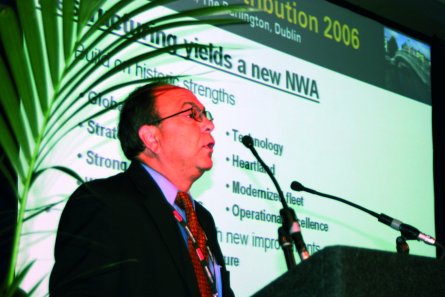This year’s Airline Distribution conference showed that the transformation in how carriers sell and distribute their tickets still has a long way to go
There are two serial offenders that airlines point to when it comes to unjustified price rises: airports and the Global Distribution Systems (GDS). The on-going battle between airlines and airports is covered elsewhere in this issue, but issues surrounding the GDSs were very much the centre of attention at Airline Distribution 2006, the annual gathering of specialists from this dynamic industry sector brought together by Airline Business and corporate travel credit card provider UATP.
This year’s event, held in the Irish capital Dublin in late March, attracted a record 215 delegates. It took place as the latest round of negotiations over pricing and content between carriers and GDSs moves into full swing. Furthermore, it gave many their first chance to quiz GDS officials on the pact between Amadeus and Sabre to back each other up with content if, and many believe when, a major carrier does finally pull out of one of the GDSs.
|
| " We have 98-99% internet penetration - something most airlines still only aspire to" Caroline Green, Ryanair |
But it was left to a carrier that has completely transformed its model away from selling its tickets via travel agencies, and therefore GDSs, to explain the importance of direct sales. Caroline Green, customer services director of Irish low-cost champion Ryanair, and a former Sabre employee herself, described how 80% of its tickets were sold via a GDS a decade ago. Direct sales via call centres got this down to 60%. “But then we came up against a brick wall,” she said.
The move to Navitaire’s Open Skies reservation system in 2000 was the revolution the carrier needed. “From that moment our business skyrocketed, not just in passenger terms, but in e-bookings,” she said. “Now we have 98-99% internet penetration, which is something most airlines still only aspire to.”
Another Irish carrier, regional player Aer Arann, was forced to take a similarly drastic step and virtually ditch GDS participation in 2001. Up until then it had been reliant on distribution through the Aer Lingus system. After the 11 September terror attacks, bookings evaporated. “We’d hit a wall, our money was being drained from us,” said managing director Padraig O’Ceidigh. Radical change was needed, and fast. Aer Arann turned itself from a feeder carrier into a point-to-point regional airline selling its seats from its own website.
So far it has proved successful, with Aer Arann looking to carry 1.3 million passengers in 2006 and making revenues of €100 million ($122 million). From selling just 15% of its seats directly in 2001 it now books 92% of its tickets on its website, says O’Ceidigh.
In home markets, or regions where an airline such as Ryanair or easyJet has a strong brand name, the direct sales route is a natural course. Carriers adopt different strategies to make it work. TAM, for instance, does not use GDSs at all in its home market of Brazil, explained Ubiritan Da Motta, its director of commercial logistics. It has developed an e-ticketing solution that travel agents use to book TAM’s tickets directly on the airline’s website. “Instead of eliminating travel agents we have to use them, our customers want to use them,” he said. “This gave TAM the ability to reduce the cost of distribution.”
|
| Dublin provided the backdrop to the Airline Distribution conference |
And cost reduction is the name of the game. Al Lenza, vice-president distribution and e-commerce at Northwest Airlines, which is working to exit Chapter 11 bankruptcy in the first quarter of 2007, knows distribution has to play its part in getting cost out of the business. “In a perfect world we would like to have 100% direct and online distribution,” he said. In the USA, online bookings are rising fast, but sales through GDSs are critical for its overseas business. “Our goal is to have very broad distribution, but at the right price point.”
That point will come into clear focus this year, especially in the USA, as the three-year deals signed between the GDSs and carriers begin to expire. These deals, which gave carriers discounts of 15-20% on per segment booking fees, were seen as a short-term solution to restructuring the relationship between the two parties. “That’s why this year is so important because we’re going to find out if we are going to achieve that goal,” said Lenza. His target price point is $4-6 per ticket regardless of channel.
Lenza pointed to the UK and Australia, where British Airways and Qantas with their hefty local market power have negotiated lower GDS fees for domestic sales, as good examples of where the model can go. In these markets travel agents actually contribute towards the carrier’s distribution cost. “Hopefully, we’ll see some movement in the USA this year,” said Lenza.
But carriers are still critical of the efforts being made by GDSs to transform their model, with its built-in annual price rises and incentive payments made to travel agents in many markets. “There is too much posturing and not enough action,” said Darren Peisley, general manager of distribution strategy and sales planning at Qantas.
However, opinions are divided over the future of incentives, which can amount to several dollars per booking. “We believe there needs to be some kind of a change in incentives to travel agents, but they won’t go away completely, there will be some kind of a blend,” said Sabre’s Reet Wiseman, vice-president northern region of Sabre Travel Network. “In this model there is financial obsolescence built into it,” said Bryan Conway, vice-president distribution Europe of Cendant. “There is potential for financial assistance to agencies to be reduced – the price needs to sit where the value sits.”
Carriers know they have to do more to encourage this change. Peisley of Qantas believes collective action by carriers, probably through the global alliances, could help deal with the problem. Robin Kamark, senior vice-president airline commercial at SAS agrees. “We haven’t been cute enough previously. In the future we will be,” he said.
“Airline business models change very quickly and we need to see their [GDS] technology and platforms keeping pace with these changes,” said Peisley. For example, the GDSs do not have great functionality to add change fees when a booking is altered, he said.
While large carriers have greater leverage because of their market size, it is different for smaller players. “There are some more open discussions, but they are still pretty much as in the past,” said Linda Stichelbaut, information and process manager of SN Brussels. Wiseman of Sabre noted that its ability to negotiate in Europe is stifled by the region’s regulated GDS market. “That is why we need to bring in the entire IT portfolio,” she said, which enables the GDS to create packages with a lower booking fee in exchange for the carrier taking other Sabre products and services.
As carriers and GDSs search for their new model, alternative distribution systems (also known as Global Distribution New Entrants) or direct connect solutions are influencing the debate. Although still in testing, Lufthansa Systems’ director airline solutions, Georg Bolz, said its FACE GNEs will become operational this year. “They will be serious contenders,” he said, “and will have full content, including discounted fares, but at lower cost.” US firm ITA Software is integrating its GNE platform with several US and some international carriers and it is being used by a handful of US travel agencies to make bookings today, said Michael Randall, its vice-president of business development.
GNEs could help carriers connect directly to corporate travel agents or Travel Management Companies (TMCs). “We do see the value that a TMC can give us, the question is how to push into that protected market?” said Oliver Wigdahl, sales and distribution consultant at UK-based low-cost player easyJet. “We’re the ones waiting to see what the GDSs will do. After all, they all pay the travel agencies not to move,” said Wigdahl. Watch this space. ■
GDS pact takes flak
 |
The announcement of a pact between arch-rivals Amadeus and Sabre to back each other up if either lost the right to distribute a particular airline’s fares and content produced heated debate during Airline Distribution in Dublin.
Maurice Coleman of Aer Lingus described it as a “blatant attempt to stifle competition”. For Al Lenza (pictured) of Northwest Airlines it showed a “lack of confidence that they can’t manage their relationships with airlines”.
There are more questions than answers at present. “Does their contract with us allow for this type of connectivity from one to the other, and how is the insurance triggered?” asked Lenza. “We may ask the DoT [US Department of Transportation] to look into this to see if it is anti-competitive.”
Amadeus and Sabre fought gamely to justify the move. “It is just an insurance policy to ensure we can maintain content,” said Reet Wiseman of Sabre Travel Network. “We are hoping we don’t have to implement it.” Amadeus argues that it serves 75,000 travel agencies with a guarantee of airline content and cannot envisage losing it. “We are discussing with airlines ways of keeping that content,” said Paul Burrows, Amadeus regional director northern Europe.
In practice, the deal is an insurance policy and is characterised as the GDS version of codesharing. Cendant said it does not need a similar back-up agreement.
MARK PILLING / DUBLIN
Source: Airline Business


















